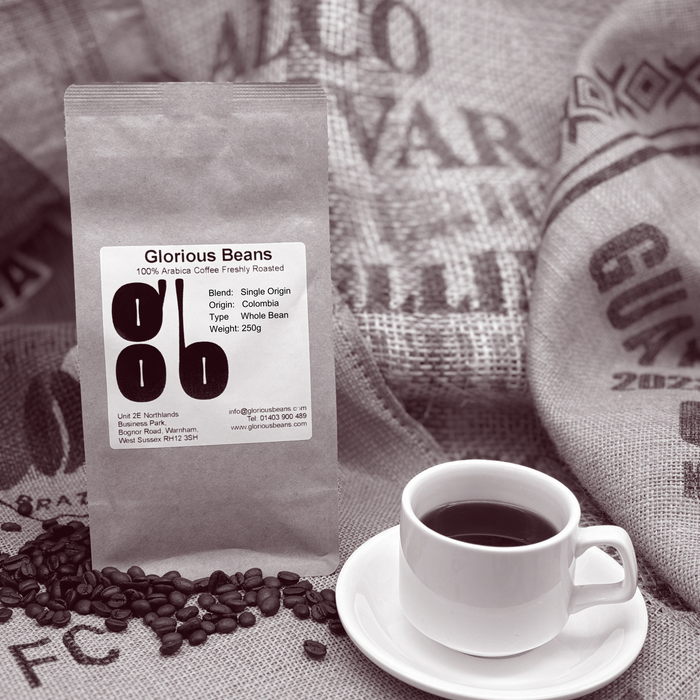Everything You Should Know Before Buying SOE Single Origin Espresso
Everything You Should Know Before Buying SOE Single Origin Espresso
Blog Article
Comprehending Coffee Beans: the Trip From Espresso to Blended Coffee Beans

The Beginnings of Coffee: An International Perspective
While you could assume of coffee as a contemporary staple, its origins map back centuries, linking with cultures around the world. The tale begins in Ethiopia, where tale states a goat herdsman called Kaldi discovered the invigorating effects of coffee beans after discovering his goats romping energetically after eating them. This sparked passion, leading to coffee's infect Arab investors who cherished the brewed beverage. By the 15th century, it got to Persia, Egypt, and Turkey, where coffee shops ended up being social centers for discussion and culture.
As profession paths increased, coffee made its means to Europe in the 17th century, swiftly obtaining appeal. It changed from a magical beverage right into a day-to-day ritual, motivating celebrations and intellectual exchanges. Each culture added its unique twist to coffee prep work, enriching its background. This global trip highlights just how coffee attaches us, transcending borders and unifying varied customs with a straightforward bean.
Growing and Harvesting of Coffee Beans
As coffee's journey advanced, the emphasis shifted to the farming and harvesting of particular bean selections, specifically those utilized for coffee. You'll discover that espresso beans often originate from Arabica or Robusta plants, each offering unique flavors. The ideal expanding problems consist of high elevations and abundant, well-drained soil, which enhance the beans' high quality.
Throughout the harvest, choosing approaches differ. In some regions, employees hand-pick ripe cherries, making sure only the most effective fruit mosts likely to handling. In various other locations, mechanical harvesters are utilized, particularly on larger farms. When the cherries get to peak ripeness for maximum taste., timing is vital; you want to harvest.
When harvested, the beans are planned for handling, which is necessary in determining their final preference. Understanding the farming and collecting processes gives you insight into what enters into your favorite espresso, enriching your gratitude for every mug.
Handling Methods: From Cherry to Bean
Now that you have actually discovered about harvesting coffee beans, let's discover how those cherries change right into the coffee beans you love. You'll see just how different harvesting strategies effect flavor, followed by the necessary steps of fermentation and drying. Finally, we'll damage down the milling and grading procedure that identifies your coffee's high quality.
Harvesting Techniques Described
When it involves coffee, comprehending harvesting techniques is necessary, since they straight impact the taste and top quality of the beans you appreciate. There are two main approaches: selective picking and strip selecting. Selective selecting entails hand-picking just ripe cherries, ensuring you obtain the very best top quality beans. This method frequently results in a richer flavor account, though it's even more labor-intensive. On the other hand, strip selecting means collecting all cherries at as soon as, no matter ripeness. While it's quicker and less expensive, this can result in a mix of tastes, affecting the end product. Ultimately, the option of gathering technique can considerably affect your coffee experience, so it deserves understanding just how those beans made it to your mug.
Fermentation and Drying Out
After gathering, the following actions in handling coffee beans play a considerable duty in shaping their taste. You'll discover that fermentation is crucial, as it assists damage down the mucilage surrounding the beans, enhancing their taste account. Depending upon the approach, this process can last from a few hours to a number of days, with varying results based on temperature level and moisture.
Sun-drying enables the beans to soak up tastes from the environment, while mechanical drying assurances consistent moisture degrees no matter of climate. Proper drying is necessary to avoid mold and preserve the beans' top quality, inevitably affecting your cup of coffee.
Milling and Grading Refine
As fermentation and drying established the phase for flavor growth, the milling and grading process warranties that just the very best coffee beans make it to your mug. This phase includes eliminating the outer layers of the coffee cherry, consisting of the parchment and husk. After milling, the beans are sorted by dimension and weight, guaranteeing an uniform top quality. You'll discover that grading assists determine issues and categorize beans, which influences taste and aroma. High-quality beans get a greater grade, causing a richer coffee experience. As soon as rated, the beans are all set for product packaging and delivery, preserving their distinct features. This meticulous procedure is necessary for supplying the extraordinary taste you appreciate in every sip of your favorite mixture.
Toasting Techniques: Unlocking Taste Prospective
When you roast coffee beans, the approach you select can drastically affect the taste account. Understanding the relationship between time, temperature level, and toasting methods is essential to revealing the potential of your brew. Allow's check out how these aspects integrated to produce the ideal cup.
Toasting Methods Explained
While you may think that all coffee roasting techniques yield the exact same results, the fact is that each method discloses special flavor capacities in the beans. Drum toasting uses a rotating drum to uniformly distribute heat, enhancing caramelization and creating a balanced flavor. Air roasting, on the other hand, flows warm air around the beans, promoting a lighter roast with obvious you could look here level of acidity.

Impact on Flavor Account
Different toasting techniques not only affect the procedure however likewise greatly influence the flavor account of the coffee beans. When you select a light roast, you'll experience brilliant acidity and floral notes, showcasing the bean's origin. On the other hand, a tool roast equilibriums acidity with sweet taste, frequently disclosing chocolatey touches. Dark roasts, on the various other hand, draw out bold, great smoky flavors, in some cases covering up the bean's one-of-a-kind qualities. Each technique discloses various oils and compounds, bring about a vast array of flavors. By try out various roasting styles, you can find which accounts reverberate with your palate. Recognizing these nuances aids you appreciate the creativity behind your mug of coffee, improving your general experience with every sip.
Time and Temperature Level Variables
To release the complete taste capacity of coffee beans, both time and her latest blog temperature level during the toasting procedure play significant functions. When toasting, you'll discover that greater temperatures can swiftly create flavors, but if you rush it, you may end up with scorched notes. On the other hand, lower temperature levels enable a more gradual taste advancement, showcasing the beans' one-of-a-kind characteristics.

Timing is just as important; extending the roast too long can bring about a loss of level of acidity and brightness, while as well brief a roast could leave the beans underdeveloped. Discovering that pleasant area requires practice and trial and error. By readjusting these aspects, you can reveal the abundant, intricate flavors concealed within each bean, creating an absolutely exceptional coffee experience.
The Art of Mixing: Crafting Unique Coffee Profiles

Beginning by picking a base coffee that offers a strong foundation. A bright Ethiopian bean can bring fruitiness, while a rich Brazilian coffee adds body.
As you mix, remember that each mix informs a tale. You're not simply making coffee; you're developing an experience. Take your time, preference often, and take pleasure in the trip of finding your trademark mix - Single Origin Espresso.
Developing Approaches: How Preparation Influences Taste
Mixing coffee opens up a domain name of flavor opportunities, yet exactly how you brew that blend can considerably influence your final mug. On the other hand, a pour-over highlights the coffee's quality and brightness, ideal for showcasing fragile notes.
Coffee, with its high pressure, creates a concentrated shot that highlights sweet taste and crema. If you favor a lighter brew, take into consideration a cool brew method; it produces a smooth, less acidic taste.
Ultimately, experimentation is crucial. Adjusting variables like water temperature level, grind dimension, and brew time can change your coffee's account. So, accept the art of developing to uncover the flavors concealed in your coffee blends. The right method can raise your experience to new heights.
The Future of Coffee: Sustainability and Innovation
As the coffee sector progresses, sustainability and development are ending up being essential for resolving environmental challenges and meeting customer needs. You'll notice that more coffee business are embracing eco-friendly methods, from sourcing beans fairly to applying lasting farming techniques. These shifts not only assist the earth however likewise improve the high quality of the coffee you enjoy.
You could see advancements like naturally degradable product packaging and water-saving brewing approaches that decrease waste. Advanced modern technology, such as blockchain, is also becoming popular, making sure openness in the supply chain, which allows you to map your coffee back to its origins.
Additionally, investing in local neighborhoods and supporting farmers through reasonable trade campaigns fosters an extra sustainable coffee community. As you sip your following cup, bear in mind that your selections can add to a brighter future for coffee. By selecting sustainable brand names, you're not just delighting in a beverage; you're making a favorable continue reading this effect on the world.
Regularly Asked Questions
What Is the Distinction Between Arabica and Robusta Beans?
Arabica beans are smoother, sweeter, and have a higher level of acidity, while robusta beans are stronger, a lot more bitter, and contain more caffeine. You'll see these differences in taste and fragrance when making your coffee.
Just How Does Elevation Affect Coffee Bean Taste?
Elevation impacts coffee bean flavor considerably. Greater elevations create beans with brighter acidity and complicated tastes, while lower elevations commonly generate beans that are larger and less nuanced. You'll observe these distinctions in your mug!
What Are the Health Advantages of Alcohol Consumption Coffee?
Consuming coffee can boost your energy, boost mental emphasis, and even enhance physical efficiency. It's rich in antioxidants, may decrease the danger of certain conditions, and can advertise a healthier metabolic process when consumed in moderation.
Can Coffee Beans Be Recycled for Developing?
Yes, you can reuse coffee beans for brewing, but the taste could be weaker. If you take pleasure in trying out, try recycling them in various ways, like chilly brews or contributing to smoothie mixes for an extra kick.
Just how Should I Shop Coffee Beans for Freshness?
To keep your coffee beans fresh, store them in an impermeable container in a great, dark area. Avoid exposing them to heat, dampness, or light, as these variables can rapidly deteriorate their taste and scent.
Recognizing Coffee Beans: the Trip From Coffee to Blended Coffee Beans.
Now that you have actually learned concerning collecting espresso beans, allow's discover just how those cherries change right into the coffee beans you enjoy.When you roast coffee beans, the approach you pick can dramatically impact the taste account - Single Origin Espresso.While you might think that all coffee roasting techniques produce the very same results, the truth is that each technique discloses distinct taste potentials in the beans.Various roasting methods not just influence the process yet likewise substantially influence the taste profile of the coffee beans
Report this page